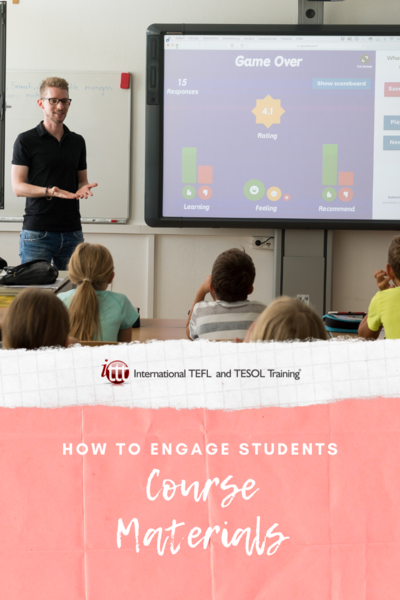Course Materials: How to Engage Students

There are many goals for English as a second language teacher (ESL). The teacher must inform and evaluate student abilities to competently produce written and verbal communication in the English language. Ultimately, one of the most important goals for the teacher to achieve is a reduction in their own talk time and an increase in student talk time (STT), using the target language. Creating a positive classroom environment is essential in generating students that have high levels of productivity. This environment is established well by building rapport and engaging the students. Having varied course materials incorporated in each lesson will help to maintain engagement for the learner and with enough diversity and fun in the activities, rapport should remain intact. Course materials such as cassettes, DVD'S and worksheets can all be adapted to fit in with the three main sections of a lesson whether it be the Engage phase, study phase or Activate phase.
Table of Contents
Do you want to teach English abroad? Take a TEFL course!
This post was written by our TEFL certification graduate Paul D. Please note that this blog post might not necessarily represent the beliefs or opinions of ITTT.
What are coursebooks for?
Teachers and learners often feel the most detached from each other in the initial stages of any new learning. This is the time where the students have not yet experienced education under the guidance of the teacher while the teacher does not understand the needs and interests of the students. Learning a new language can be a scary concept for many students so making sure that they feel comfortable in the learning environment is necessary to maximize comprehension. This is where building rapport comes into place. The coursebook will guide the content being delivered however it will not create rapport with educators and students or even students with their peers. This rapport is first established through getting to know each other and it is up to the teacher to create communication channels that feel encouraging and inviting and using course materials will enhance this task.

Also Read: How to find a job teaching English in Spain?
ESA method
For the Engage phase of a lesson rather than relying on the coursebook initially, teachers could have visual aids such as pictures drawn or cut out from magazines depicting images that reflect the teacher's home country. This may work best in multilingual classes however should still be successful in monolingual classes just not as time-consuming. Students would appreciate walking into their first class and seeing images rather than lots of foreign words on a board that would surely be intimidating. From here the teacher can elicit vocabulary that helps the students describe what their country looks like, or even distribute magazines for them to find their images depending on the learning level. The students can build vocabulary and even conversation from the images which are not only interesting to them, but also visual stimuli have shown to increase retention. As teachers show interest in the student's own countries the rapport builds.
Student talking time
Looking at the original goal of increasing STT, it is apparent that reliance on coursebook alone will lead to poor pronunciation and a lack of exposure to demonstrating the target language audibly. Our receptive skills and productive skills are equally important in learning language therefore using audio-visual equipment is beneficial to improving the speaking skills of learners. In the current technological age, it is expected that most students will have smartphones. Rather than creating tension with students in attempts to remove their attention from their phones, it may ideal to help them see how they can use the phones to aid the learning. Recording dialogue and even filming conversations between students on their phones has multiple advantages. The students can playback the recordings and self-assess through comparisons to the teacher. It can also help with understanding phonology particularly by viewing the movements of the mouth with certain words.

Also Read: Should I take a TEFL course online or in a classroom?
Video content
Presenting videos and worksheets to students continues to diversify the learning and allow more understanding. Once rapport is established educators can locate videos that interest the students and can even aid in reinforcing knowledge for false beginners as they may recall language from previous viewings of the content. In the study phase worksheets can be derived from the coursebook itself however these are often generic and creating tailored worksheets for the class may seem more time consuming however the added personal touch such as incorporating the student's names will help to continue engagement and rapport.

Also Read: 37 Key English Teaching Terms Explained
Classroom environment
If the understanding is that the classroom environment creates a positive atmosphere of which the students feel comfortable to learn, then the onus is on the teacher to make sure this can be established. Teachers need to check their available resources and learning space. Equipment may work for one teacher in one class such as an Overhead projector against a white wall and may not work in another class due to the coloring of the wall. Recording devices and any audio-visual equipment can all be prone to failure, so it is important to check the functionality of materials before lessons and have back up planned well in advance.
Students using devices such as smartphones can lead to distractions. This can particularly be a problem when students are placed in pair-work scenarios. Pair-work alleviates students from intimidation or shyness of presenting to the whole class. And can also lead to students teaming up with their friends and reverting to the native language. In these situations, it is important teachers monitor the whole class and diversify the pairings of students. If everyone is getting different partners in each pair-work exercise, the students who are behaving inappropriately won't feel singled out when they are separated, and the focus will be on the activity.
Do you want to teach English abroad? Take a TEFL course!
These were just several examples of course materials and the benefits they have in shaping the class. Learning will always thrive in an environment that is dynamic. A truly holistic approach to teaching English will give the students a broader range of learning the content. Various learning styles and resources mean a greater chance of every student performing well.
Apply now & get certified to teach english abroad!
Speak with an ITTT advisor today to put together your personal plan for teaching English abroad.
Send us an email or call us toll-free at 1-800-490-0531 to speak with an ITTT advisor today.
Related Articles:
- Top 10 Things to Know When Moving Abroad to Teach English
- The 5 Most Common Types of EFL Students and How to Deal with Them
- The Lowdown on Teaching English Abroad With a Family
- 9 Small Details That Matter When Teaching EFL
- 8 Amazing Things You Can Do with a TEFL Certificate
- Differences in Teaching Monolingual and Multilingual EFL Groups




